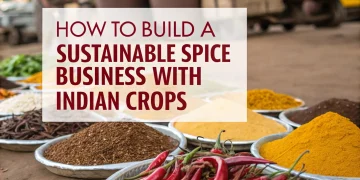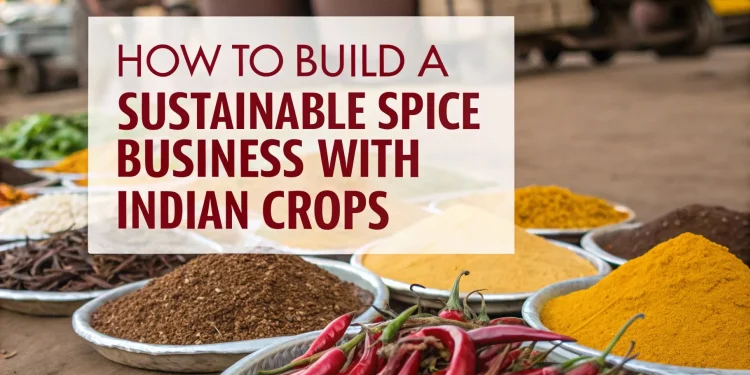Introduction to Sustainability in the Spice Sector
When most people hear the word sustainability, they think of keeping the oceans clean or using less plastic at home. But for businesses, especially those that rely on Spice business and farming and long supply chains, going green is no longer optional—it’s the new standard. In the spice world, that shift is already underway, and it starts with every tiny seed. Shoppers now want to know not just how a blend tastes but whether the farmers were paid fairly, the soil stayed healthy, and the packaging can be recycled.
To meet those questions, spice companies need a road map that connects every step of the journey, from planting in the field to landing on grocery shelves. The Handbook on Spices, Seasonings, Condiments, Processing & Extraction, published by NIIR, spells out practical ideas like water-saving irrigation, fair-trade sourcing, and energy-efficient drying so owners can turn good intentions into everyday actions.
India’s Legacy and Leadership in Spice Production
For more than 2,000 years, spice traders have sailed from Indian ports with stories and flavors that still circle the globe. Today India holds the crown as the biggest grower, buyer, and shipper of spices, thanks to a climate that swings from Kerala’s rain-soaked hills to the dry plains of Rajasthan. That mix of weather allows farmers to raise over 75 distinct species side by side, placing the country at the forefront of sustainable agriculture and showing the world what climate-smart farming can look like.
India has always grown spices, but the old ways—like planting several crops together, using neem sprays instead of chemicals, and making compost at home—give modern green farming a strong cultural backbone. When farms bring back these traditions and add a little technology, they can boost quality, cut costs, and ride out climate shocks.
Related: Extraction of Curcumin from Turmeric
Crafting a Sustainable Spice Business Model
Being truly sustainable touches on three big areas:
- Environmental health means caring for soil, saving water, using less energy, and protecting wildlife.
- Economic health calls for fair prices, steady earnings for growers, and a business that lasts.
- Social health pushes for honest work, equal pay for women and men, and active local partnerships.
A spice business that lives up to all three picks greener fertilizers, funds solar pumps, shrinks plastic, tracks every jar, and still meets quality and profit goals.
Star Crops for Green Indian Farming
Some Indian spices fit this green vision better than others because they grow strong, need few extra inputs, and sell well at home and abroad.
- Turmeric loves loamy ground and hardly touches synthetic fertilizer. After harvest it leaves the soil richer for the next crop.
- Ginger grows best in raised beds covered with straw and watered by drip lines, which cuts waste.
- Cardamom may seem picky, but shade trees in an agroforestry plot protect forests and give the pods a sweet flavor.
- Cumin and coriander thrive in dry climates and actually do well with light irrigation and natural pest helpers.
The NIIR handbook lays out step-by-step growing tips, so farms can pick the best seed types for their local soil and market needs.
Using the NIIR Handbook as a Sustainability Framework
The NIIR’s Spice Handbook is a must-have for anyone who wants to build a green spice business. It’s not just a guide; it gives clear, repeatable steps for processing that cuts waste and keeps machines running smoothly.
The book shows how to use fewer chemicals, set up integrated pest controls, and run HACCP lines with less heat and water. For startups aiming for green labels, it spells out tests, supplier checks, and easy compliance roadmaps.
When producers follow this systems-based plan, they cut their carbon and water footprints while still delivering top-quality, safe spices.
Related: For Complete Details, Get The Book Here.
Organic Farming and Certification Pathways
Turning every farm to organic methods is a key part of going green. The handbook walks growers through each move needed to shift from conventional practices to full organic certification.
In India, farmers wanting to sell spices as “organic” can choose the home-grown Participatory Guarantee System (PGS-India) or the stricter National Programme for Organic Production (NPOP). Both work well for local sales. On the global stage, labels like USDA Organic and EU Organic unlock better prices and create a stronger brand.
The NIIR handbook walks producers through simple steps for keeping soil healthy, using compost, green manure, and bio-fertilisers. It also lays out the paperwork auditors expect, from field-history notes to input logs and residue-test results.
Reducing Water and Energy Use in Processing
Sustainable spice businesses must tackle the way they waste water and energy, since each drop and each unit counts against the bottom line. To help, the handbook describes drying-tools that run on sun or biomass, cutting grid-power loads and trimming carbon footprints.
Once spices are picked, washing can still use too much water. Keeping a recycling loop, using low-flow nozzles, and capturing rain are quick fixes. Pair them with energy-smart motors, programmable logic controllers, and meters that beep when use spikes, and firms gain real control.
Cutting fossil-fuel runs and city-water calls not only green a brand but also trim bills, leaving space to invest back into quality or more sustainable practices.
Eco-Friendly Packaging Options for Spice Products
Packaging creates a mountain of waste in the spice business. To tackle this, the latest handbook points to smart swaps for plastic laminates:
- Plant-cellulose films that break down in nature
- Corn-starch polymer pouches that compost at home
- Glass jars with screw-on lids aimed at premium buyers
- Recycled paperboard boxes printed in a single color
It also advises a clean, minimalist look—less ink, less fluff, smaller sizes—to trim material use and stay in step with zero-waste goals.
When packaging is done right, it shields the spices and also shouts the brand’s green promise to shoppers who care.
Related: Launch Your Spice Business: The Ultimate Handbook for Entrepreneurs
Minimizing Waste Through By-Products and Recycling
Leftover bits from cleaning cardamom pods or grinding clove buds don’t have to go straight into the dump. Instead, the NIIR guide shows how to turn scraps into:
- Bio-compost that feeds the next crop of spices
- Biomass fuel that powers drying machines
- Steam-distilled oils from husks and stems
- Natural pigments for paints and fabrics
By thinking in circles, producers cut landfill loads and pocket a little extra money.
Traceability and Transparency in Sustainable Branding
Today’s shoppers want to know exactly where their food comes from. The NIIR handbook recommends simple tools—batch coding, blockchain records, or a quick QR label—that connect each item back to its origin story.
When brands make this journey visible, they build trust, meet safety rules, and show they care about ethical sourcing. Companies with traceable, story-rich products often enjoy stronger customer loyalty and can charge a premium price.
Community and Farmer Empowerment Models
True sustainability looks after people, not just the planet. The Handbook on Spices backs farmer cooperatives that let small growers share costs, split profits, and learn new skills together.
It also calls for hiring more women in processing, paying clear wages, and funding local projects like biogas systems or cold-storage units. Such steps lift communities and create a tough, inclusive supply chain.
For more information check our project reports
Sustainable Supply Chains and Local Sourcing
Transport can quietly add a lot of carbon to any product. Buying spices from local growers cuts those emissions while pumping money into nearby economies.
The handbook suggests setting up regional hubs where farmers deliver fresh crops to processors just down the road. This approach saves fuel, speeds deliveries, and always keeps quality high.
Because they operate closer to home, these local models bounce back faster when the world hits a rough patch, whether that’s a pandemic or a political crisis.
Green Certification Opens Doors
Today, a green seal of approval is like a passport to international shelves. Big retailers across Europe and North America now favor suppliers who can show they walk the sustainability talk.
The guide walks you through programs such as:
- Fair Trade International
- Rainforest Alliance
- EU Green Deal alignment
- Carbon-neutral certification
These badges do more than widen sales; they also attract impact investors and funds that care about environmental, social, and governance scores.
Exporting Sustainably Grown Indian Spices
Sustainable spices are in high demand across the globe. The NIIR handbook details how to prepare for exports through:
- Clean-label declarations
- Residue testing reports
- Environmental compliance certificates
- Customs documentation for eco-certified goods
It also includes tips on selecting export partners, participating in global food fairs, and leveraging government incentives like India’s Agricultural and Processed Food Products Export Development Authority (APEDA) schemes.
Case Studies: Successful Sustainable Spice Brands
The book includes case studies of Indian spice exporters and startups who’ve built sustainable brands from scratch. For example:
- A turmeric farm in Tamil Nadu that transitioned to organic and doubled income through German exports.
- A spice startup in Gujarat using solar dryers and biodegradable packaging that secured funding from an impact VC firm.
These stories prove that eco-conscious choices are not just good ethics—they’re good economics.
Challenges in Going Sustainable and How to Overcome
Going green isn’t without hurdles. High certification costs, lack of infrastructure, and initial yield dips are common barriers. The handbook advises phased implementation—starting with low-cost interventions like water-saving, then scaling to full certification.
It also recommends partnering with NGOs, government programs, and private accelerators that provide technical support and funding for sustainability transitions.
Conclusion: The Future of Sustainable Spice Trade
Sustainability is not just a trend—it’s the foundation of tomorrow’s spice economy. Building a sustainable spice business with Indian crops is both an opportunity and a responsibility. With global demand for eco-friendly, traceable, and ethically sourced spices on the rise, the time to act is now.
The Handbook on Spices, Seasonings, Condiments, Processing & Extraction by NIIR is your blueprint for turning this vision into reality. It offers the technical, practical, and strategic tools needed to create a spice business that’s profitable, responsible, and future-ready.


















